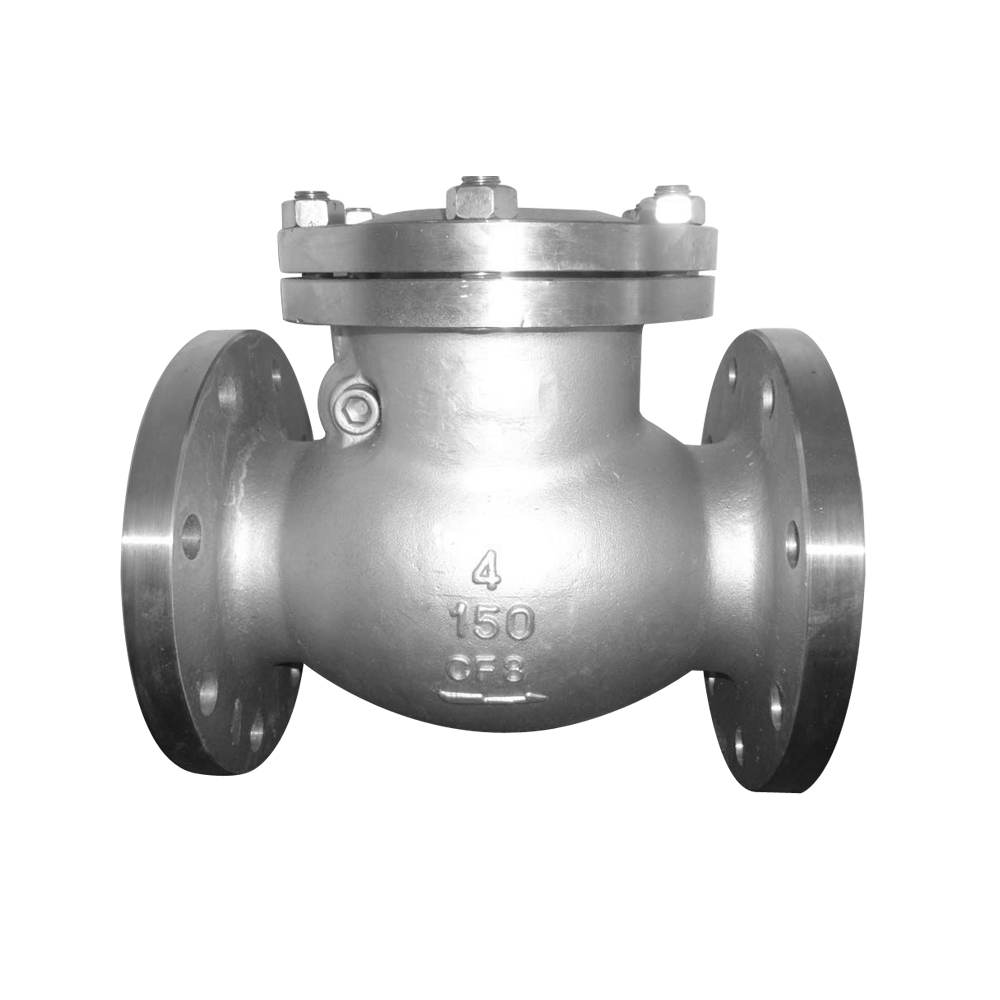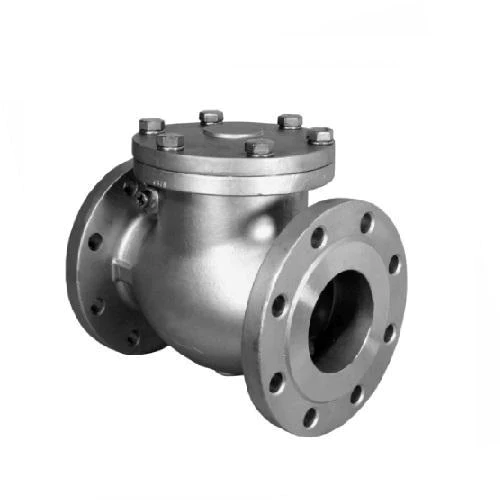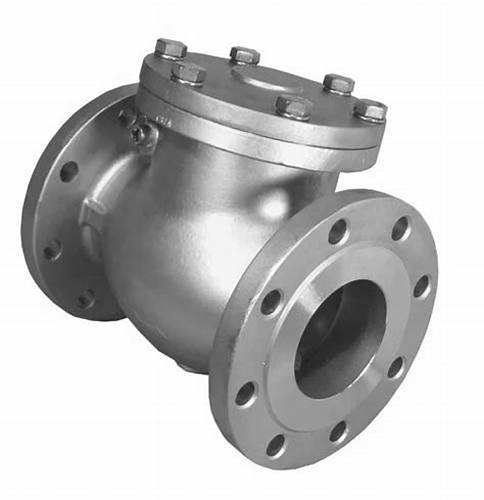Stainless Steel Swing Check Valve | Flanged & Durable
In the complex world of fluid control systems, reliability is paramount. The stainless steel swing check valve stands as a cornerstone technology, ensuring unidirectional flow and protecting critical equipment from the damaging effects of backflow and water hammer. This comprehensive guide delves into every facet of the ss swing check valve, from industry trends and technical specifications to manufacturing excellence and real-world applications. We will provide an in-depth analysis of the H44W-16/25/40P,R model, demonstrating why it represents the pinnacle of performance and durability in its class.
Industry Trends: The Rising Demand for High-Performance Check Valves
The global industrial valve market is on a significant upward trajectory, projected to reach over USD 90 billion by 2028. A key driver of this growth is the increasing demand for high-performance, corrosion-resistant valves. The stainless steel swing check valve is at the forefront of this trend, favored for its robustness in demanding environments found in petrochemical, water treatment, power generation, and pharmaceutical industries. Stricter environmental regulations (e.g., EPA guidelines) and the need for process efficiency are compelling industries to upgrade their legacy systems. Stainless steel, particularly grades like 304 and 316L, offers superior resistance to corrosive media and high temperatures, making it the material of choice over traditional cast iron or bronze in critical applications.

Data from leading market analysis reports indicate a compound annual growth rate (CAGR) of over 5.5% for the check valve segment, with stainless steel models leading the charge. This is attributed to their long service life, reduced maintenance costs, and compliance with stringent international standards like ISO 9001 and API (American Petroleum Institute) standards, which are becoming non-negotiable for major projects worldwide.
Technical Deep Dive: The H44W-16/25/40P,R Stainless Steel Swing Check Valve
Understanding the technical parameters of a check valve is crucial for selecting the right component for your system. The H44W series is a premier example of a stainless steel flanged check valve, engineered for optimal performance and longevity. Let's explore its key features and specifications.
Featured Product: H44W-16/25/40P,R Stainless Steel Swing Check Valve
Experience unmatched reliability and performance. This valve is designed to meet and exceed the most rigorous industry standards, providing a secure and efficient solution for preventing backflow in your critical pipelines.
View Product Details & Request a QuoteKey Technical Specifications
| Parameter | Specification | Industry Significance |
|---|---|---|
| Model | H44W-16/25/40P, R | Designates Swing Check Valve (H44), Stainless Steel Body (P/R), and Pressure Ratings. |
| Nominal Diameter (DN) | DN40 - DN600 (1.5" - 24") | Covers a wide range of pipe sizes for diverse industrial applications. |
| Pressure Rating | PN16, PN25, PN40 (Class 150, 300) | Indicates the maximum operating pressure the valve can safely withstand. |
| Body/Disc Material | CF8(304), CF8M(316), CF3(304L), CF3M(316L) | High-grade stainless steel ensures superior corrosion and temperature resistance. CF8M (316) is ideal for highly corrosive media. |
| Sealing Face | 13Cr, Stellite (STL), Stainless Steel | Hardened sealing surfaces provide a tight shut-off (meeting API 598 standards) and resist wear and erosion. |
| End Connection | Flanged (RF, FF, RTJ) | Standardized flange connections (ASME B16.5, DIN) ensure easy and secure installation into existing pipelines. |
| Design Standard | ASME B16.34, API 6D, BS 1868 | Compliance with these standards guarantees valve design, integrity, and safety. |
| Testing Standard | API 598 | Ensures every valve is hydrostatically and pneumatically tested for shell and seat leakage before shipping. |
Performance Visualization
Data-driven insights highlight the superior qualities of the H44W series. The charts below illustrate material application suitability and pressure handling capabilities, key factors in valve selection.
Application by Industry (Typical Distribution)
A pie chart showing the dominant use of stainless steel valves in Petrochemical and Water Treatment industries.
Pressure Rating Performance
A bar chart demonstrating the suitability of different pressure classes (PN16, PN25, PN40) for various operational pressures.
From Raw Material to Flawless Performance: The Manufacturing Process
The exceptional reliability of a stainless steel swing check valve is not accidental; it is the result of a meticulous and controlled manufacturing process. We combine advanced technology with stringent quality control at every stage, adhering to standards like ISO 9001 for quality management. Here’s a detailed look at our manufacturing journey.

Step-by-Step Manufacturing Flowchart
1. Material Inspection
Spectrometer analysis of raw stainless steel (CF8/CF8M) to verify chemical composition.2. Investment Casting
Creating the valve body and disc using precision investment casting for complex shapes and fine surface finish.3. CNC Machining
High-precision CNC machining of sealing faces, flange surfaces, and hinge pin holes to tight tolerances (within ±0.02mm).4. Assembly & Fitting
Skilled technicians assemble the body, disc, hinge, and gasket in a clean environment.5. Pressure Testing
100% of valves undergo hydrostatic and pneumatic testing per API 598 to ensure zero leakage.This process ensures that every stainless swing check valve leaving our facility is a product of precision engineering. Key highlights include:
- Material Traceability: Full material traceability from raw ingot to finished product, with MTR (Material Test Reports) available.
- Precision Machining: Use of 5-axis CNC centers ensures perfect alignment and sealing, minimizing "cracking pressure" (the minimum pressure required to open the valve) and enhancing energy efficiency.
- Rigorous Testing: Beyond API 598, valves for critical services can undergo NDT (Non-Destructive Testing) like Radiographic Testing (RT) or Dye Penetrant Inspection (DPI).
- Expected Lifespan: With proper installation and maintenance, our H44W valves are designed for a service life exceeding 15-20 years, even in corrosive environments.
Technical Advantages & Competitive Edge
Choosing the right valve goes beyond just meeting pressure and size requirements. The H44W stainless steel swing check valve offers distinct advantages that translate into lower total cost of ownership and enhanced system reliability.

Manufacturer Comparison: HBYS Valves vs. Generic Alternatives
| Feature | Our H44W-Series Valve | Generic/Standard Competitor |
|---|---|---|
| Material Certification | EN 10204 3.1 certification provided standard | Often basic compliance, certification may be extra |
| Sealing Technology | Precision-lapped Stellite 6 hardfacing for zero leakage | Standard integrated or basic 13Cr seal |
| Hinge Pin Design | Anti-rotation, robust hinge pin to prevent wear and failure | Simple pin design, prone to wear over time |
| Casting Quality | ASTM A351 grade castings with superior surface finish | Standard casting quality, may have higher porosity |
| Testing Protocol | 100% API 598 tested (shell, seat, backseat) | Batch testing or optional testing |
| Warranty | Comprehensive 24-month warranty | Standard 12-month warranty |
The key takeaway is a focus on long-term performance. While a generic valve might have a lower initial price, our commitment to superior materials, precision engineering, and exhaustive testing ensures a significantly longer, trouble-free service life, preventing costly downtime and maintenance.
Customization and Real-World Application Scenarios
Every fluid system is unique. That's why we offer extensive customization options to tailor our stainless steel swing check valve to your specific needs. From material selection for exotic media to special end connections, we provide engineered solutions, not just products.
Customization Solutions:
- Special Alloys: For extreme corrosion, we offer Duplex, Super Duplex, and Hastelloy C options.
- Cryogenic Service: Modifications for LNG and other cryogenic applications, including extended bonnets.
- Special Coatings: PTFE/PFE lining for non-stick properties and enhanced chemical resistance.
- Actuation: Options for counterweights or hydraulic dampers to control valve closure speed and mitigate water hammer.
Typical Application Scenarios:

Petrochemical & Refining
In hydrocarbon processing, the ss swing check valve is critical on the discharge side of pumps and compressors to prevent backflow of flammable or corrosive fluids, protecting expensive equipment and ensuring process safety. The 316/316L (CF8M/CF3M) material is essential for handling sour gas and other corrosive substances, often requiring compliance with NACE MR0175.

Water & Wastewater Treatment
Used extensively in municipal water distribution and treatment plants to prevent contaminated water from flowing back into the clean water supply. The corrosion resistance of 304/316 stainless steel is vital for handling chlorinated water and various treatment chemicals, ensuring a long service life and compliance with public health standards (e.g., NSF/ANSI 61).
Application Case Study & Customer Experience
Case Study: Solving Chronic Backflow Issues at a Coastal Desalination Plant
Client: A major reverse osmosis (RO) desalination facility on the coast.
Problem: The facility was experiencing frequent failures of their existing bronze check valves on the high-pressure brine discharge lines. The high salinity and pressure were causing rapid corrosion and seat leakage, leading to pump damage from back-pressure surges and unplanned shutdowns, costing an estimated $50,000 per incident in lost production and repairs.
Solution: Our engineering team recommended replacing the failing valves with our H44W stainless steel swing check valve in Super Duplex stainless steel (CD3MWCuN / Grade 5A). The Super Duplex material was chosen for its exceptional resistance to chloride-induced stress corrosion cracking (a common failure mode in coastal environments). We also specified Stellite hardfaced seats for maximum durability against the abrasive, high-velocity brine.
Outcome (Experience): After installing our valves, the facility has operated for over 36 months with zero valve-related failures on that line.
Key Metrics:
- 100% Reduction in unscheduled downtime due to check valve failure.
- 90% Reduction in valve maintenance costs for that section of the plant.
- Measurable Improvement in pump efficiency and lifespan due to stable back-pressure conditions.
"The expertise in material selection was a game-changer. The HBYS stainless steel swing check valve has been absolutely bulletproof. It's a true 'install and forget' solution that has saved us significant time and money."
Our Commitment to Trust and Authority
Trust is earned through transparency, quality, and unwavering customer support. We build this trust by adhering to the highest global standards and backing our products with robust guarantees and accessible expertise.
Authoritativeness & Certifications:
Our commitment to quality is validated by internationally recognized certifications and standards:
- ISO 9001:2015: Certified quality management system.
- API 6D Monogram: Licensed to manufacture valves to the American Petroleum Institute's standard for pipeline valves.
- CE Marking (PED): Compliance with the European Pressure Equipment Directive 2014/68/EU.
- Trusted By: Our valves are integral components in systems operated by leaders in the global energy, chemical, and water sectors.
Trustworthiness & Guarantees:
- Delivery & Logistics: Standard delivery cycle of 4-6 weeks for common sizes. Expedited options are available. We provide full logistical support, including certified packing and global shipping.
- Quality Assurance & Warranty: Every stainless steel swing check valve is backed by a minimum 24-month warranty against manufacturing defects. We provide comprehensive documentation, including MTRs, pressure test certificates, and certificates of conformity with every shipment.
- Customer Support: Our team of valve experts is available 24/7 to assist with technical queries, installation guidance, and troubleshooting.
Frequently Asked Questions (FAQ)
Both are excellent austenitic stainless steels. The primary difference is that 316 stainless steel (CF8M) contains molybdenum (typically 2-3%). This addition significantly enhances its resistance to corrosion, particularly from chlorides (like saltwater) and sulfuric acids. Rule of thumb: Use 304 (CF8) for general water, food processing, and mild chemicals. Use 316 (CF8M) for marine applications, chemical processing, pharmaceuticals, and any environment with high chloride exposure.
Yes, but with a critical consideration. A standard ss swing check valve can be installed in a horizontal line or in a vertical line with the flow direction pointing upwards. Gravity helps the disc close in both scenarios. It should NEVER be installed in a vertical line with downward flow, as the disc will remain open regardless of flow conditions. For specific orientations or pulsating flow, a valve with a counterweight or spring-assisted closure might be necessary.
Water hammer (or hydraulic shock) is a high-pressure surge caused by a fluid in motion being forced to stop or change direction suddenly. A standard swing check valve can sometimes contribute to water hammer if it slams shut too quickly when flow reverses (e.g., a pump shuts off). To mitigate this, we offer options like dampers (hydraulic dashpots) or external counterweights that control the closing speed of the disc, allowing it to close gently and preventing the dangerous pressure spike.
A stainless steel swing check valve offers a full, unobstructed port, resulting in very low pressure drop, making it ideal for high-volume, low-velocity applications where energy efficiency is key. A lift check valve has a more tortuous flow path (higher pressure drop) but is generally better for high-pressure service and can be more effective in preventing chattering in pulsating flow. Swing checks are the most common type for general-purpose applications due to their simplicity and low head loss.
These are standards that define the dimensions and tolerances for pipe flanges to ensure interchangeability. ASME B16.5 is the American standard, widely used in North America and the oil & gas industry globally. It defines flange dimensions based on pressure classes (e.g., 150#, 300#). DIN (Deutsches Institut für Normung) is the German standard, prevalent in Europe. It uses PN (Pressure Nominal) ratings (e.g., PN16, PN40). It is crucial to specify the correct flange standard to match your existing pipeline.
These valves are designed for low maintenance. However, periodic inspection (e.g., annually) is recommended. This involves checking the flange bolts for proper torque and visually inspecting for any external leakage from the body-bonnet gasket. In critical services, a more thorough internal inspection every 3-5 years to check the condition of the seat, disc, and hinge pin can prevent unexpected failures and extend the valve's life significantly.
Cracking pressure is the minimum amount of upstream pressure required to "crack" open the valve disc and allow flow to begin. For a standard stainless steel swing check valve, this pressure is very low (typically less than 0.5 psi), which is a major advantage as it minimizes energy loss in the system. For applications requiring a specific backpressure to be held, spring-loaded check valves with a defined cracking pressure are used.
Industry References & Further Reading
To further enhance your understanding of fluid dynamics and valve technology, we recommend exploring insights from authoritative sources in the industry. These publications provide in-depth analysis and research that underpin the design principles of high-performance valves.
- Skousen, P. L. (2004). Valve Handbook. McGraw-Hill. - A foundational text on valve design, selection, and application.
- "Understanding Check Valve Selection and Sizing." Valve Magazine, Spring 2021. Available at: https://www.valve-magazine.com (Note: This is a representative link to the magazine's homepage).
- Zappe, R. W. (1991). Valve Selection Handbook. Gulf Publishing Company. - Focuses on the practical aspects of selecting the right valve for specific services.
-
The Key to Fluid Control: Exploring the Advantages of Ball Valves in Industrial SystemsNewsJul.09,2025
-
The Versatile World of 1, 2, and 3 Piece Ball ValvesNewsJul.09,2025
-
Stainless Steel Ball Valves: The Ideal Choice for Efficient Flow ControlNewsJul.09,2025
-
Optimizing Fluid Control with Ball Float ValvesNewsJul.09,2025
-
Manual Gate Valves: Essential for Control and EfficiencyNewsJul.09,2025
-
Everything You Need to Know About Butterfly ValvesNewsJul.09,2025
-
The Versatility of Wafer Type Butterfly ValvesNewsJul.08,2025




